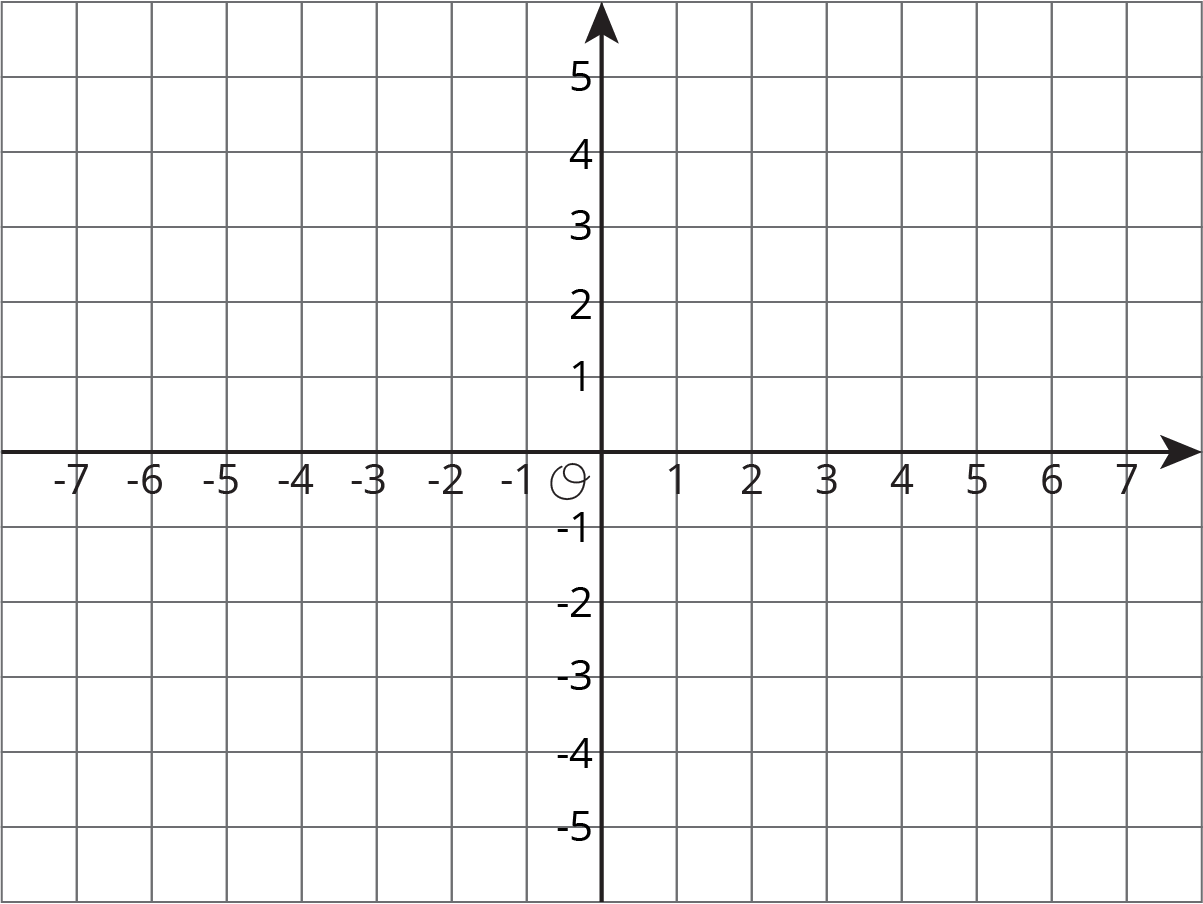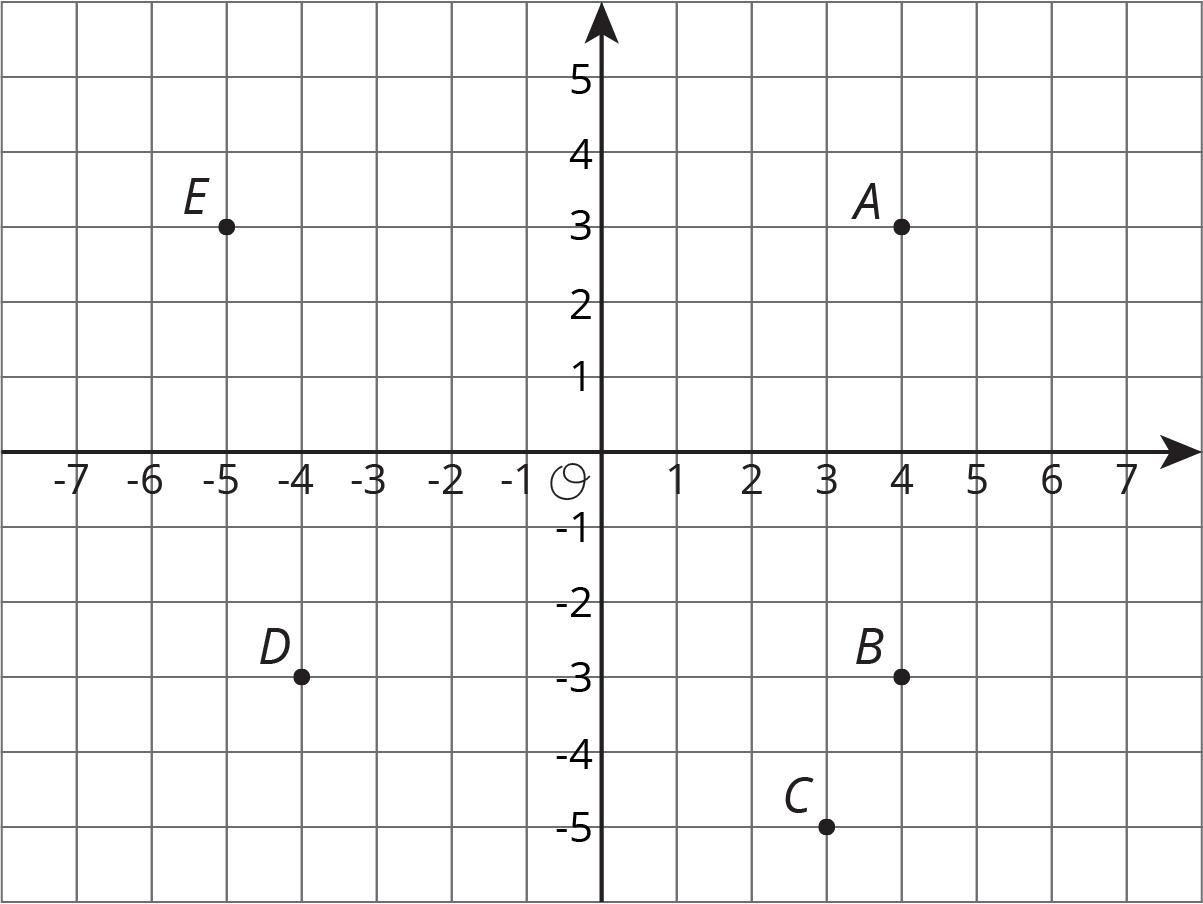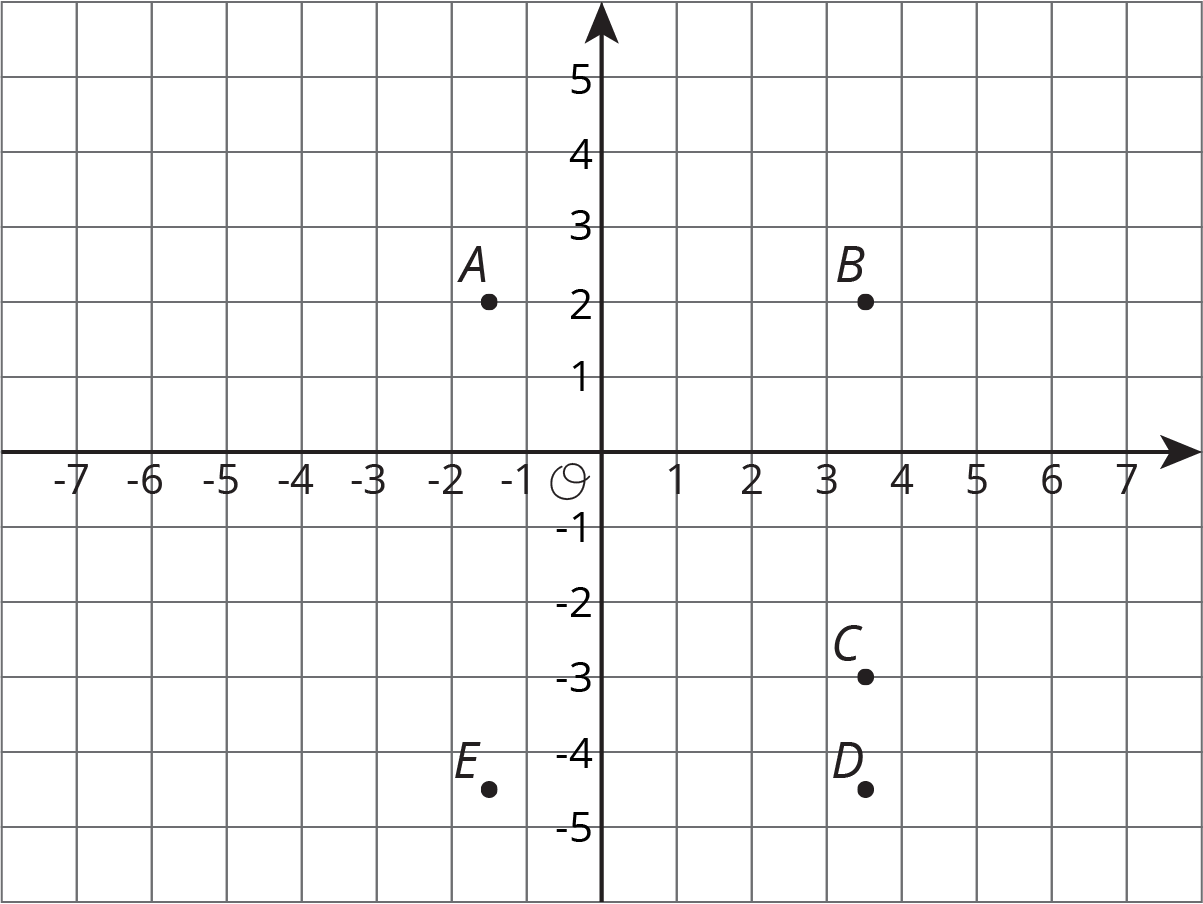Lesson 14
Distances on a Coordinate Plane
14.1: Coordinate Patterns (10 minutes)
Warm-up
The purpose of this warm-up is for students to review plotting and labeling points that include negative coordinates and use repeated reasoning to generalize patterns in the coordinates of points in each quadrant (MP8).
Launch
Arrange students in groups of 4. Assign each person in a group a different quadrant. Tell students you will give them 2 minutes to plot and label at least three points in their assigned quadrant, and up to six if they have time. Give students 2 minute of quiet work time. Give students 4 minutes to share their points and their coordinates with their small group and look for patterns in the coordinates of points in each quadrant. Follow with whole-class discussion.
Though the paper and pencil version may be preferred, a digital applet is available for this activity.
Student Facing
Plot points in your assigned quadrant and label them with their coordinates.
Student Response
For access, consult one of our IM Certified Partners.
Launch
Arrange students in groups of 4. Assign each person in a group a different quadrant. Tell students you will give them 2 minutes to plot and label at least three points in their assigned quadrant, and up to six if they have time. Give students 2 minute of quiet work time. Give students 4 minutes to share their points and their coordinates with their small group and look for patterns in the coordinates of points in each quadrant. Follow with whole-class discussion.
Though the paper and pencil version may be preferred, a digital applet is available for this activity.
Student Facing
Plot points in your assigned quadrant and label them with their coordinates.

Student Response
For access, consult one of our IM Certified Partners.
Activity Synthesis
The focus of the discussion is for students to explain why the following patterns emerge:
- In quadrants I and IV, the x-coordinate of a point (or the first number in an ordered pair) is positive.
- In quadrants II and III, the x-coordinate of a point is negative.
- In quadrants I and II, the y-coordinate of a point (or the second number in an ordered pair) is positive.
- In quadrants III and IV, the y-coordinate of a point in is negative.
Ask the students to share any patterns they noticed among the coordinates of the points in each quadrant. After each student shares, ask the rest of the class if they noticed the same pattern within their small group. Record and display these patterns for all to see. If possible, plot and label a few example points in each quadrant based on students' observations.
14.2: Signs of Numbers in Coordinates (15 minutes)
Activity
The purpose of this task is for students to connect opposite signs in coordinates with reflections across one or both axes. Students investigate relationships between several pairs of points in order to make this connection more generally (MP8). The square grid, spaced in units, means that students can use counting squares as a strategy for finding distances.
The use of the word "reflection" is used informally to describe the effect of opposite signs in coordinates. In grade 8, students learn a more precise, technical definition of the word "reflection" as it pertains to rigid transformations of the plane.
Launch
Arrange students in groups of 2. Allow students 3-4 minutes of quiet work time and 1-2 minutes to check results with their partner for questions 1 and 2. Tell students to pause after question 2 for whole-class discussion. At that time, briefly check that students have the correct coordinates for points \(A\), \(B\), \(C\), \(D\), and \(E\) before moving on to the rest of the questions. Give students 4 minutes to answer the rest of the questions with their partner, followed by whole-class discussion.
Though the paper and pencil version may be preferred, a digital applet is available for this activity.
Design Principle(s): Cultivate conversation
Student Facing
-
Write the coordinates of each point.
- \(A=\)
- \(B=\)
- \(C=\)
- \(D=\)
- \(E=\)
-
Answer these questions for each pair of points.
- How are the coordinates the same? How are they different?
- How far away are they from the y-axis? To the left or to the right of it?
- How far away are they from the x-axis? Above or below it?
-
\(A\) and \(B\)
-
\(B\) and \(D\)
-
\(A\) and \(D\)
Pause here for a class discussion.
-
Point \(F\) has the same coordinates as point \(C\), except its \(y\)-coordinate has the opposite sign.
- Plot point \(F\) on the coordinate plane and label it with its coordinates.
- How far away are \(F\) and \(C\) from the \(x\)-axis?
- What is the distance between \(F\) and \(C\)?
-
Point \(G\) has the same coordinates as point \(E\), except its \(x\)-coordinate has the opposite sign.
- Plot point \(G\) on the coordinate plane and label it with its coordinates.
- How far away are \(G\) and \(E\) from the \(y\)-axis?
- What is the distance between \(G\) and \(E\)?
-
Point \(H\) has the same coordinates as point \(B\), except both of its coordinates have the opposite signs. In which quadrant is point \(H\)?
Student Response
For access, consult one of our IM Certified Partners.
Launch
Arrange students in groups of 2. Allow students 3-4 minutes of quiet work time and 1-2 minutes to check results with their partner for questions 1 and 2. Tell students to pause after question 2 for whole-class discussion. At that time, briefly check that students have the correct coordinates for points \(A\), \(B\), \(C\), \(D\), and \(E\) before moving on to the rest of the questions. Give students 4 minutes to answer the rest of the questions with their partner, followed by whole-class discussion.
Though the paper and pencil version may be preferred, a digital applet is available for this activity.
Design Principle(s): Cultivate conversation
Student Facing
- Write the coordinates of each point.

\(A=\)
\(B=\)
\(C=\)
\(D=\)
\(E=\)
-
Answer these questions for each pair of points.
- How are the coordinates the same? How are they different?
- How far away are they from the y-axis? To the left or to the right of it?
- How far away are they from the x-axis? Above or below it?
-
\(A\) and \(B\)
-
\(B\) and \(D\)
-
\(A\) and \(D\)
Pause here for a class discussion.
-
Point \(F\) has the same coordinates as point \(C\), except its \(y\)-coordinate has the opposite sign.
- Plot point \(F\) on the coordinate plane and label it with its coordinates.
- How far away are \(F\) and \(C\) from the \(x\)-axis?
- What is the distance between \(F\) and \(C\)?
-
Point \(G\) has the same coordinates as point \(E\), except its \(x\)-coordinate has the opposite sign.
- Plot point \(G\) on the coordinate plane and label it with its coordinates.
- How far away are \(G\) and \(E\) from the \(y\)-axis?
- What is the distance between \(G\) and \(E\)?
-
Point \(H\) has the same coordinates as point \(B\), except its both coordinates have the opposite sign. In which quadrant is point \(H\)?
Student Response
For access, consult one of our IM Certified Partners.
Activity Synthesis
The key takeaway is that coordinates with opposite signs correspond to reflections across the axes. Encourage students to share ideas that they discussed with their partner. Ask students first about what patterns they noticed for pairs of points whose \(x\)-coordinates had opposite signs. Push students to give specific examples of pairs of points and their coordinates, and to describe what opposite \(x\)-coordinates mean in terms of the coordinate plane. Record students' explanations for all to see. Students may use phrasing like "the point flips across the \(y\)-axis." This would be a good opportunity to use the word "reflection" and discuss the similarities between reflections across the \(y\)-axis and reflections in a mirror.
Repeat this discussion for pairs of points where the \(y\)-coordinates had opposite signs to get to the idea that they are reflections across the \(x\)-axis. Close by discussing the relationship between points \(H\) and \(B\), where both the \(x\)- and \(y\)-coordinates have opposite signs. Ask students how they might describe the relationship between \(H\) and \(B\) visually on the coordinate plane. While students may describe the relationship in terms of 2 reflections (once across the \(x\)-axis and again across the \(y\)-axis or vice versa), it is not expected that students see their relationship in terms of rotation.
Supports accessibility for: Visual-spatial processing; Conceptual processing
14.3: Finding Distances on a Coordinate Plane (15 minutes)
Activity
The purpose of this activity is for students to develop strategies for finding the distance between two points in the coordinate plane when the coordinates might not be integers. These distances are restricted to horizontal and vertical distances; use of the general two-dimensional distance formula is not expected, nor are students expected to add or subtract negative numbers fluently. More general strategies for finding distance in the coordinate plane are developed in grade 8, and rational number arithmetic is developed more completely in grade 7.
Launch
Arrange students in groups of 2. Allow students 5–6 minutes of quiet work time 3–4 minutes to check results with their partner. Follow with a whole-class discussion.
Though the paper and pencil version may be preferred, a digital applet is available for this activity.
Supports accessibility for: Organization; Attention
Design Principle(s): Cultivate conversation
Student Facing
-
Label each point with its coordinates.
-
Find the distance between each of the following pairs of points.
-
Point \(B\) and \(C\)
-
Point \(D\) and \(B\)
-
Point \(D\) and \(E\)
-
- Which of the points are 5 units from \((\text-1.5, \text-3)\)?
- Which of the points are 2 units from \((\text0.5, \text-4.5)\)?
- Plot a point that is both 2.5 units from \(A\) and 9 units from \(E\). Label that point \(F\) and write down its coordinates.
Student Response
For access, consult one of our IM Certified Partners.
Launch
Arrange students in groups of 2. Allow students 5–6 minutes of quiet work time followed by 3–4 minutes to check results with their partner. Follow with a whole-class discussion.
Though the paper and pencil version may be preferred, a digital applet is available for this activity.
Supports accessibility for: Organization; Attention
Design Principle(s): Cultivate conversation
Student Facing
-
Label each point with its coordinates.

-
Find the distance between each of the following pairs of points.
-
Point \(B\) and \(C\)
-
Point \(D\) and \(B\)
-
Point \(D\) and \(E\)
-
- Which of the points are 5 units from \((\text-1.5, \text-3)\)?
- Which of the points are 2 units from \((\text0.5, \text-4.5)\)?
- Plot a point that is both 2.5 units from \(A\) and 9 units from \(E\). Label that point \(M\) and write down its coordinates.
Student Response
For access, consult one of our IM Certified Partners.
Student Facing
Are you ready for more?
Priya says, “There are exactly four points that are 3 units away from \((\text- 5, 0)\).” Lin says, “I think there are a whole bunch of points that are 3 units away from \((\text- 5, 0)\).”
Do you agree with either of them? Explain your reasoning.
Student Response
For access, consult one of our IM Certified Partners.
Anticipated Misconceptions
Some students may assume that a diagonal line across a number of squares has the same length. Ask students to use a ruler or tracing paper to compare the length of the diagonal distance in question against the horizontal or vertical distance the student claims is equal.
Activity Synthesis
The important idea students should come away with is that they can continue to use strategies they have developed for finding horizontal and vertical distances even without a context. Here are some questions for discussion:
- How did finding lengths in this activity compare to the previous activity? How were they the same? How were they different?
- Were any of the points reflections across the axes? How could you tell by looking at the coordinate plane? How could you tell by looking at the coordinates?
- Were there any points of disagreement with your partner? How did you come to agreement?
Lesson Synthesis
Lesson Synthesis
The activities in this lesson asked students to analyze the effect of replacing coordinates with their opposites and to find horizontal and vertical distances in the coordinate plane. Here are some questions for discussion:
- “Without graphing, what can you say about the points \((5, \text-3)\) and \((5,3)\) on the coordinate plane?” (Sample responses: The first point is in quadrant IV and the second point is in quadrant I. They are both 3 units from the \(x\)-axis. They are reflections across the \(x\)-axis. They are 6 units apart. They are both on the same vertical line.)
- “Without graphing, what can you say about \((\text-6,4)\) and \((6,4)\) on the coordinate plane?” (Sample responses: The first point is in quadrant II and the second point is in quadrant I. They are both 6 units from the \(y\)-axis. They are reflections across the \(y\)-axis. They are 12 units apart. They are both on the same horizontal line)
- “Without graphing, what can you say about \((2.5,1)\) and \((6,1)\) on the coordinate plane?” (Sample responses: they are both in quadrant I. They are both on the same horizontal line because they have the same \(y\)-value. The second point is 3.5 units to the right of the first point.)
If time allows, challenge students to draw, for example, a rectangle with given side lengths, and identify its vertices. This will lead nicely into the next lesson, where students will explore shapes in the coordinate plane. Select student responses to display for all to see.
14.4: Cool-down - Points and Distances (5 minutes)
Cool-Down
For access, consult one of our IM Certified Partners.
Student Lesson Summary
Student Facing
The points \(A = (5, 2), \,B = (\text-5, 2), \, C = (\text-5, \text-2)\), and \(D=(5, \text-2)\) are shown in the plane. Notice that they all have almost the same coordinates, except the signs are different. They are all the same distance from each axis but are in different quadrants.

Notice that the vertical distance between points \(A\) and \(D\) is 4 units, because point \(A\) is 2 units above the horizontal axis and point \(D\) is 2 units below the horizontal axis. The horizontal distance between points \(A\) and \(B\) is 10 units, because point \(B\) is 5 units to the left of the vertical axis and point \(A\) is 5 units to the right of the vertical axis.
We can always tell which quadrant a point is located in by the signs of its coordinates.
| \(x\) | \(y\) | quadrant |
|---|---|---|
| positive | positive | I |
| negative | positive | II |
| negative | negative | III |
| positive | negative | IV |

In general:
- If two points have \(x\)-coordinates that are opposites (like 5 and -5), they are the same distance away from the vertical axis, but one is to the left and the other to the right.
- If two points have \(y\)-coordinates that are opposites (like 2 and -2), they are the same distance away from the horizontal axis, but one is above and the other below.
When two points have the same value for the first or second coordinate, we can find the distance between them by subtracting the coordinates that are different. For example, consider \((1,3)\) and \((5,3)\):

They have the same \(y\)-coordinate. If we subtract the \(x\)-coordinates, we get \(5-1=4\). These points are 4 units apart.